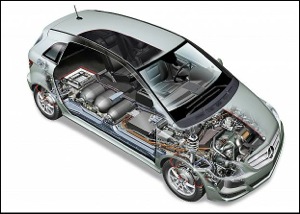 Daimler AG, Ford Motor Company and Nissan Motor Co., Ltd., have signed a unique three-way agreement to accelerate the commercialization of fuel cell electric vehicle (FCEV) technology.
Daimler AG, Ford Motor Company and Nissan Motor Co., Ltd., have signed a unique three-way agreement to accelerate the commercialization of fuel cell electric vehicle (FCEV) technology.
The goal of the collaboration is to jointly develop a common fuel cell electric vehicle system while reducing investment costs associated with the engineering of the technology. Each company will invest equally towards the project. The strategy to maximize design commonality, leverage volume and derive efficiencies through economies of scale will help to launch the world’s first affordable, mass-market FCEVs as early as 2017.
Together, Daimler, Ford and Nissan have more than 60 years of cumulative experience developing FCEVs. Their FCEVs have logged more than 10 million km in test drives around the world in customers’ hands and as part of demonstration projects in diverse conditions. The partners plan to develop a common fuel cell stack and fuel cell system that can be used by each company in the launch of highly differentiated, separately branded FCEVs, which produce no CO2 emissions while driving.
The collaboration sends a clear signal to suppliers, policymakers and the industry to encourage further development of hydrogen refueling stations and other infrastructure necessary to allow the vehicles to be mass-marketed.
Powered by electricity generated from hydrogen and oxygen, FCEVs emit only water while driving. FCEVs are considered complementary to today’s battery-electric vehicles and will help expand the range of zero-emission transportation options available to consumers.
“Fuel cell electric vehicles are the obvious next step to complement today’s battery electric vehicles as our industry embraces more sustainable transportation,” said Mitsuhiko Yamashita, Member of the Board of Directors and Executive Vice President of Nissan Motor Co., Ltd., supervising Research and Development. “We look forward to a future where we can answer many customer needs by adding FCEVs on top of battery EVs within the zero-emission lineup.”
“We are convinced that fuel cell vehicles will play a central role for zero-emission mobility in the future. Thanks to the high commitment of all three partners we can put fuel cell e-mobility on a broader basis. This means with this cooperation we will make this technology available for many customers around the globe,” said Prof. Thomas Weber, Member of the Board of Management of Daimler AG, Group Research & Mercedes-Benz Cars Development.
“Working together will significantly help speed this technology to market at a more affordable cost to our customers,” said Raj Nair, group vice president, Global Product Development, Ford Motor Company. “We will all benefit from this relationship as the resulting solution will be better than any one company working alone.”
Engineering work on both the fuel cell stack and the fuel cell system will be done jointly by the three companies at several locations around the world. The partners are also studying the joint development of other FCEV components to generate even further synergies.
The unique collaboration across three continents and three companies will help define global specifications and component standards, an important prerequisite for achieving higher economies of scale.
How a fuel cell electric vehicle works
Like today’s battery-electric vehicles, FCEVs are more efficient than conventional cars and diversify energy sources beyond petroleum.
The electricity for an FCEV is produced on board the vehicle in the fuel cell stack where it is generated following an electro-chemical reaction between hydrogen – stored in a purpose-designed, high-pressure tank in the car – and oxygen from the air. The only by-products are water vapor and heat.


